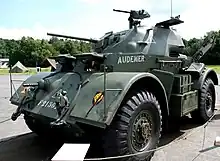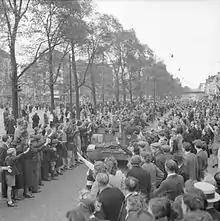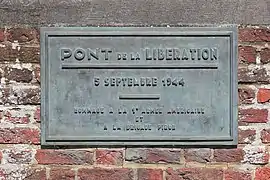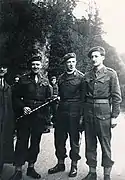Independent Belgian Brigade
The Independent Belgian Brigade was a Belgian and Luxembourg military unit in the Free Belgian forces during World War II, commonly known as the Piron Brigade (Brigade Piron) after its commanding officer Jean-Baptiste Piron. It saw action in Western Europe and participated in the Battle of Normandy, the Liberation of Belgium, and fighting in the Netherlands over 1944-1945.
| Independent Belgian Brigade "Piron Brigade" | |
|---|---|
 Early insignia of the Brigade Piron | |
| Active | January 1943 – 17 November 1945 |
| Country | |
| Allegiance | Belgian government in exile |
| Branch | Free Belgian Forces |
| Type | Brigade group with motorised, artillery, reconnaissance, engineer and support elements |
| Size | 2,200 officers and men |
| Part of | Guards Armoured Division |
| Nickname(s) | Piron Brigade |
| Engagements | Operation Paddle Liberation of Belgium and Netherlands |
| Commanders | |
| Notable commanders | Jean-Baptiste Piron |
| Insignia | |
| First designation | First Group (Late 1942-January 1943) |
| Second designation | First Belgian Brigade (January 1943-July 1944) |
| Third designation | Independent Belgian Brigade (July 1944-November 1945) |
Origins
Brigade Piron originated in 1940, with hundreds of Belgian soldiers who had escaped to Britain, as had the Belgian Government. A new command of the Belgian Army, under Lieutenant-General Victor van Strydonck de Burkel, was created in Tenby on 25 May 1940, three days before the Belgian capitulation. Van Strydonck de Burkel became commander of the Belgian Forces in Great Britain in June 1940 and in the same month, a Belgian Minister (Jaspar) called upon all Belgians to come to Britain to continue fighting.
At the end of July 1940 there were 462 men in the Belgian Forces in exile; the arrival of many Belgians allowed the creation of several military units. The troops were trained in Great Britain and Canada and in 1942, Major Jean-Baptiste Piron arrived in Scotland where he quickly joined the army staff, with the responsibility of improving the training of Belgian troops. In an artillery competition, the Belgian battery came first. The Belgian Forces in Britain were officially made available to the Allies on 4 June 1942. By the end of the year the army had been restructured, including the creation of the 1st Belgian Brigade, under the command of Major Piron, with a mix of infantry, artillery and reconnaissance units. Troop training continued through 1943 and landing exercises were conducted in early 1944. A Luxembourgish unit was assigned to Brigade Piron in March, forming an artillery troop. In total about 116 luxembourgers served in the unit.[1] Because the Belgians had arrived from around the world, thirty-three languages were spoken in the Brigade in 1944.
Normandy invasion

The D-Day landings took place on 6 June 1944 without Brigade Piron, to the great disappointment of its 2,200 men but the British preferred to reserve them for the liberation of Belgium. (This policy was applied to all of the smaller national military contingents, which were expected to form the basis of post-war armies and for whom it would have been difficult to find replacements for casualties.) Piron lobbied the Belgian government in exile, which requested the British Government to send the Belgian troops to the front, to reverse the declining morale of those troops.
On 29 July 1944, the Brigade was ordered to be ready to move. Its first units arrived in Normandy on 30 July and the main body arrived at Arromanches and Courseulles on 8 August, before the end of the Battle of Normandy. The Brigade operated under the command of the British 6th Airborne Division (Major General Gale), which was part of the First Canadian Army.[2] The Belgians entered active service on 9 August.
The Belgian Brigade participated in Operation Paddle, Clearing the Channel coast from 17 August with British and Dutch (Prinses Irene Brigade) troops of the 6th Airborne Division. Merville-Franceville-Plage was liberated in the evening, Varaville on 20 August. The Brigade's armoured vehicles were detached to assist British units. Dives-sur-Mer and Cabourg were taken on the morning of 21 August and Houlgate in the afternoon. The Brigade took Villers-sur-Mer and Deauville on 22 August, and Trouville-sur-Mer and Honfleur at the mouth of the Seine on 24 August. The bridge connecting the communes of Deauville and Trouville-sur-Mer was renamed to "Pont des Belges" and still bears a commemoration[3] to the Brigade which liberated the communes.
The Belgian armoured vehicles were reunited with the rest of the Brigade on 26 August at Foulbec. On 28 August 1944, the Brigade was placed under the British 49th Infantry Division in order to mop up the Seine estuary and help in the siege of Le Havre.[2] On 29 August, the Brigade crossed the Seine to support Operation Astonia, the attack on Le Havre on the following day. At the last moment the Brigade was withdrawn from the front and transferred to the Second Army for operations in Belgium. The efforts of Brigade Piron on Normandy's Côte Fleurie are commemorated by memorials, road names and war graves.
Belgium and the Netherlands

On 2 September, the Brigade and the Dutch Princess Irene Brigade had been transferred to the Second Army and ordered to move as quickly as possible to the Belgian border. The British were already in Belgium and expected to enter Brussels on the following day and this transfer would allow the Belgian and Dutch Brigades to operate in their homelands.[4] The Brigade arrived at the French–Belgian border on 3 September, after an overnight journey and continued to Rongy in Brussels the following day, just after the British.
In early September the Brigade acted as guides for British soldiers, attempted to aid Resistance fighters, and took part in mine-clearing at the Evere and Melsbroek airports. The Brigade entered northern Belgium on 3 September 1944,[2]
On 11 September 1944, the Brigade participated in a battle at the Albert Canal bridgehead and helped to capture Leopoldsburg liberating 900 political prisoners.[2]
During Operation Market Garden the Brigade was assigned to guard the right flank of the British 30th corps.
On 25 September 1944 the Brigade reached the Wessem canal with fighting reaching its peak on 11 November 1944. Six days later the Brigade was withdrawn and reorganized into a proper brigade for the first time at Leuven.[2]
During their advance through Belgium, the Belgian troops were sometimes mistaken for French Canadians, since local people did not expect that their liberators would be fellow Belgians. Brigade Piron liberated other Belgian towns and cities before reaching the Netherlands border on 22 September. Its campaign in the Netherlands lasted until 17 November, when it was relieved from the front and moved into reserve in Leuven. In the small Dutch border town of Thorn, a bridge has been named in honour of its liberation on 25 September 1944.
Brigade Piron returned to the Netherlands between 11 April 1945 and June 1945. The last casualty of the Brigade occurred on 27 April 1945. The next day, the Brigade was thrown into battle once again around Nijmegen.[2] On that day also, an armistice was implemented in the Netherlands.[2] The Brigade entered Germany in May before being disbanded in December. Its tradition was however preserved in the Bevrijding (Liberation) battalion of the 5th Regiment of the Line.[2]
Occupation of Germany
Brigade Piron occupied part of the British zone of occupation until 15 December 1945.
- Brigade Piron Pictures
 Memorial in Thorn (Limburg), The Netherlands.
Memorial in Thorn (Limburg), The Netherlands.
 Captain, chaplain and WO of the 1st Infantry Brigade.
Captain, chaplain and WO of the 1st Infantry Brigade.
Post-war
Brigade Piron formed the basis of the new Belgian Army. In a reorganisation on 17 November 1945, the Brigade's artillery and armoured units were reorganised to form specialised regiments and the engineers joined a new engineer battalion. The remaining infantry, reinforced by volunteers, became the First Brigade Liberation, based at Leopoldsburg barracks.[5]
Order of battle
In August 1944, the 1st Belgian Brigade consisted of:[6]
- Staff
- British Liaison
- 1st, 2nd and 3rd Motorised companies – each with rifle platoons reinforced by mortar, machine gun, anti-tank and anti-aircraft platoons.
- Armoured Car Squadron – 4 squadrons equipped with a mixture of Daimler Armoured Cars, Staghound armoured cars (some armed with anti-aircraft weapons) and Daimler "Dingo" Scout Cars and a supply and recovery squadron
- Artillery Battery – 12 25 pounder gun-howitzers, organised into 3 troops, one of which was Luxembourgish.
- Engineers Company
- Transport Company
- Repair Detachment
- Medical Unit
Notes
- https://static1.squarespace.com/static/5d6cd88533f26e0001129454/t/5dba9b8e3fa4f36e29e5801d/1572510610368/WW2_livre_172x240_r3-WEB.pdf
- Conway, Martin; Gotovitch, José (2001). Europe in Exile: European Exile Communities in Britain, 1940-1945. Berghahn Books. ISBN 9781571815033.
- "Pont des Belges Trouville-sur-Mer - Trouville-sur-Mer - TracesOfWar.com". www.tracesofwar.com.
- Stacey, Colonel C. P. (1966). "Clearing the Coastal Belt and the Ports: September 1944". Official History of the Canadian Army. Department of National Defence. p. 323. Archived from the original on 12 January 2010. Retrieved 10 January 2010.
- Marichal, Jean-Louis (2001–2009). "Reorganisation". Archived from the original on 6 July 2011. Retrieved 27 December 2009.
- Marichal, Jean-Louis (2001–2009). "Organization august 44". Retrieved 27 December 2009.
References
- Bibliography
- Roland Breyne, La Brigade Piron, Louvain-la-Neuve, Université Catholique de Louvain, Séminaires d'histoire contemporaine consacrés à la vie quotidienne pendant la Seconde Guerre mondiale en Brabant wallon, Hainaut et Namurois, 1985, 78 pages.
- (in Dutch) Inge Huygebaert, Jean-Baptiste Piron, de man achter de Brigade, Koninklijke Militaire School Brussel. Alle Wapens Afdeling, 2004, 123 feuilles.
- Michael Demarets, (dessins), Carnet de Campagne. La Brigade Piron en Normandie, Ostende, Editions Erel, 1946, 56 pages.
- Pierre Musschoot, l’unité de ravitaillement de la « Brigade Piron. Un essai historique, Hamois-en-Condroz, Editions Vezham, 1999, 35 pages.
- Guy Weber, Maurice Poncelet (1904–1985), le cerveau de la Brigade Piron, S.N.S.1., date inconnue, 97 feuilles.
- (in Dutch) Louis Wuyts, De ontscheping in Normandië. Een hel van tachtig eindeloze dagen. Frans Jacobs uit Peutie bevocht de Duitsers als soldaat van Brigade Piron, Zondagnieuws, 11 juin 1984.
- (in French) André Charlier, Brigade Piron : 1944 d'un jour à l'autre, Edité à compte d'auteur, Relate la campagne de la brigade en Normandie au jour le jour.
- Press
- Anonyme, Vers l'Avenir – I. L'entraînement en Angleterre et la campagne de Normandie. – II. La campagne de Belgique, 10–11 juin 1976.
- A., H., La Dernière Heure, Ce que nous dit le général de Brigade sir Alexander B.G. Stanier (Trente ans après. "Ca m'est arrivé à la libération..."), 3 septembre 1974
- Henri Demaret, La brigade Piron, 39–45 Magazine, N° 71, 1992, p. 38–46
- Yves Aublet, La Brigade Piron, l'Athéna sur la Toucques, numéro spécial Juin/septembre 1994, numéro 120/121, Association des amis du musée de Trouville et du Passé Régional. Occupation et Libération de Trouville-Deauville et alentours. P. 100-105.
- Video
- La Brigade Piron, Bruxelles, SID, DEFENS (Bibliothèque Défense), 40 minutes.
- Actualité, Bruxelles, Televox, 1994, DEFENS (Bibliothèque Défense), 40 minutes, DEFENS: XXVI.1495 [100003713]